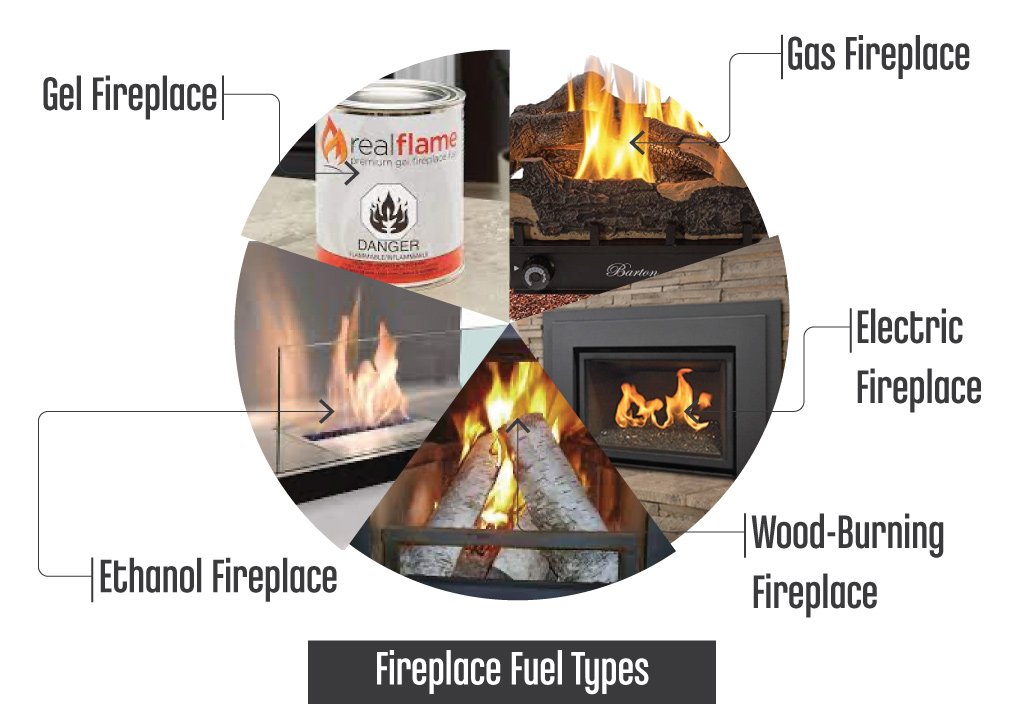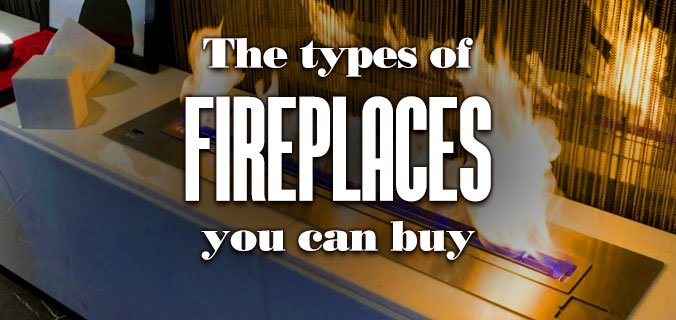There are many fireplace options to choose from, and it can often be overwhelming to decide which fireplace is right for you. That’s why we’ve put together this buying guide of fireplace types so that you’ll know precisely what fireplace will work best in your home. Below you’ll find a list of 12 types of fireplaces – from traditional wood-burning fireplaces to gas fireplace insert models that are perfect for heating the living room on those cold winter nights!
We’ve created this guide to help you make an informed decision about which type of fireplace best suits your home.
When you have a fireplace in your home, you want to ensure it’s the perfect one. There are different types of fireplaces that can fit perfectly, depending on your needs!
This is an informative guide, so get a cup of coffee and learn about your fireplace options.
Fireplace Buying Guide
Several significant decisions need to make early on when considering a fireplace purchase.
Of these choices, fuel type and mounting option are most impactful. They dictate design elements such as style, dimensions, and materials used for your fireplace.
Besides the fireplace itself, you can also choose from a variety of mantels and flues.
Fireplace Fuel Types
When getting a fireplace, the first thing you need to decide is what type of fuel will use.
Choosing a fuel type will dictate the best mounting style and design and give you better insight into where to place it.
There are many types of fireplace fuels, and the most common are electric, gas, gel, ethanol, or wood.

1. Electric Fireplace
If you’re looking for an electric fireplace, check out their most popular variety: Infrared fireplaces.
Electric fireplaces design to give off heat by warming the internal coils with electricity. Most models come with an internal fan that will distribute heat more equally throughout your home.
Electric fireplaces do not emit an entirely “real” flame but rather a flame simulation through flickering and cracking sounds that mimic actual wood-burning.
To recreate the ambiance of a fireplace without excessive heat, most electric models offer you the ability to turn off the heating element and keep on the fake flickering flame.
Regardless of which type you choose, the fireplace can be turned on from the comfort of your chair. Most models come with a remote that increases or decreases the temperature and turns the fire on or off.
Among the benefits of electric fireplaces is their cost-effectiveness. They’re also among the cheapest options to install since they don’t require venting.
Furthermore, unlike gas and wood fireplaces, electric fireplaces don’t require the usual maintenance associated with them, like chopping wood or inspecting the chimney.
One of the benefits of buying an electric fireplace is safety. They are hands down the safest model for homes with children or pets.
The electric fireplace is customizable. Sub-models of the fireplace and its lighting can customise to different levels of light, brightness, and color.
2. Gas Fireplace
Another popular alternative to traditional wood-burning fireplaces is gas fireplaces.
Like electric fireplaces, gas fireplaces are a low-cost option that is usually easy to install. Built-in options can easily install as an addition to a preexisting fireplace and chimney.
Gas fireplaces are inexpensive to buy and maintain, but they’re ultimately the most efficient heating system.
Alternatively, opt for a free-standing gas fireplace that doesn’t restrict you to particular rooms. You can install this type of fireplace anywhere on your property and in many different room types.
Direct-vented models need a chimney for ventilation. This can be an existing chimney (like the one you had before) or a new one that needs to go up.
Ventless gas fireplaces are one of the many types of fireplaces available for your home and have a number of safety features to offer.
Despite the clear flame of fireplaces, they still pose a slight risk of contaminating your home.
The final option when it comes to a gas fireplace is the type of gas used. You can use natural gas or liquid propane.
A natural gas fireplace can use an existing gas line. On the other hand, a propane fireplace requires a propane tank. Both options require a line installed between the fireplace and fuel source.
3. Gel Fireplace
Unlike gas or electric fireplaces, gel-based fireplaces are less common today.
A gel fireplace will work without any venting, lines, pipes, or electrical wires because it’s fueled by a can of gel fuel.
One advantage of gel fireplaces is that they have a built-in safety system, making them safer than traditional fireplaces.
Another advantage of a this types of fireplace is that the fire is real. You light the gel with a lighter to produce an authentic flame.
This type of flame doesn’t produce much heat. It would help if you didn’t use the gel fireplace for your primary heating source.
One consideration before committing to a gel fireplace is the expense of the fuel.
4. Ethanol Fireplace
The ethanol fireplace is similar to the gel fireplace, except it runs on a liquid bioethanol fuel instead of a gel.
Ethanol fireplaces consist of a burner and fuel tank. A standard-size fuel tank is 2 liters.
The gas burner lets you control the temperature of your fireplace (unlike a gel-filled fireplace). It also allows you to turn the fireplace on or off easily.
Ethanol fireplaces are easy to install, but they aren’t very efficient. It would be best if you only used them as a supplement for heat in your home.
Like gel fireplaces, they are lightweight and an excellent choice for wall-mounted or tabletop models.
Ethanol fireplaces are quickly becoming popular, thanks to the wide variety of available designs.
5. Wood-Burning Fireplace
One of the most traditional fireplace designs is a wood-burning fireplace.
One of the earliest forms of a heating device, a wood-burning fireplace, has been used to keep inhabitants warm for centuries.
When most of us picture a fireplace, we usually think of a traditional wood-burning model.
Wood-burning fires are sustainable but can have drawbacks. The biggest drawback to wood-burning fireplaces is maintenance and cost. Wood-burning fireplaces are expensive to install, buying wood adds up, and they require professional cleaning regularly.
Despite their drawbacks, a lot of people enjoy wood-burning fireplaces. Wood-burning fireplaces create a comfortable, rustic warmth no matter what space they’re in and evoke the smokey scent that many find to be lovely.
There are different styles of fireplaces for your home. Wood-burning stoves are a perfect alternative to the traditional fireplace if you do not have space.
Fireplace Mounting Options
After finding the right fuel, select your favorite mounting option.
Remember that not all mounting options will work with every fuel type. For example, wood-burning fireplaces are much too large to hang on the walls.
The mounting options for fireplaces are traditional, free-standing, wall-mounted, built-in, and hanging.

6. Traditional Open-Hearth Fireplace
A traditional fireplace uses with a wood-burning fireplace.
Open hearth traditional fireplaces are made of stone or brick and built into a wall in a house—the exhaust fumes from flames with ventilation through the chimney and flue.
A traditional fireplace can be the most expensive option. Unless you already have one, it will require a lot of construction to install one in your home.
Most people tend to pass on a traditional open-hearth fireplace unless their home was originally constructed with one.
7. Free-Standing Fireplace
Free-standing fireplaces are a great alternative to traditional open-hearth fireplaces.
They include a mantle and mimic the look of a traditional built-in fireplace.
Many types of free-standing fireplaces use solid fuels. You’ll find that some are utterly free-standing while others are attached to the wall or ceiling for ventilation.
Free-standing fireplaces come in a variety of styles and designs, with sorts for all tastes.
Some other options for free-standing fireplaces are furniture that has built-in fireplaces. One standard option is entertainment centers.
The entertainment center has a built-in fireplace on the bottom. Your TV can then sit on top of it without worry because the mantle provides protection.
These built-in fireplaces are ideal for people who live in apartments or small homes.
8. Wall-Mounted Fireplace
A wall-mounted fireplace is another popular option for those with apartments or small homes.
These fireplaces are becoming more popular, and some types of outdoor fireplaces can be easily moved around your house.
Wall-mounted fireplaces are broken into two types: those that require a chimney to be connected and those that don’t. The type you want depends on what fuel you use.
Wall-mounted fireplaces come in dozens of varieties, including different shapes and styles. A popular design lately is the long type called a ribbon fireplace. You can buy one with or without a mantel.
Wall-mounted fireplaces are often the focal point of a room as they provide an impressive centerpiece.
9. Built-In Fireplace Insert
A fireplace insert is a good option for those who already have a built-in traditional fireplace.
Alternatively, if you have an open-hearth wood-burning fireplace and want the convenience of a new design but not the work involved in installing it, you can buy gas inserts that slide into the opening.
One way to make a wood-burning fireplace more efficient, lower maintenance, and less damaging to the environment is to convert it into another fuel type.
One great thing about fireplace inserts is that they use the space you currently have. You can opt for traditional designs or pick one with a more modern style.
10. Tabletop Fireplace
The Tabletop fireplaces are easy to transport and are an excellent solution for event planners.
Tabletop fireplaces are used mostly for outdoor heating spaces. Place a small one on the ground for your guests to enjoy while you provide an eye-catching focal point at night.
Tabletop fireplaces are a great way to give your space a personal touch.
11. Hanging Fireplace
I’m not a big fan of the hanging style because it has that distinctive futuristic vibe.
12. Two-Sided Fireplace
This is a type of fireplace that provides options for use in two rooms.
Fireplace Frequently Asked Questions
Can fireplaces be removed?
Yes, fireplace removal is usually possible. Cost depends on the degree of work required by a homeowner and can vary widely. Some jobs can be completed for less than $1,000, while complete removals are more costly. The price of the removal fireplace depends on its size, the number of fireplaces, and the types of materials it is made of.
Can fireplaces be painted?
Yes, it is safe to paint a fireplace. Exterior paint can provide heat resistance and decoration. Experts recommend exterior walls paint with acrylic latex paint rated for up to 200 degrees Fahrenheit. Some paint manufacturers make paints appropriate for different types of materials, such as stone, brick, and stucco. You’ll need to check the fire rating on any paint you choose. Inside the fireplace, your safest paint is a high-heat paint that withstands 1200° Fahrenheit. Recommended application methods are roller or spray made for textures.
Can fireplace ashes use to fertilize the garden?
Ashes from wood fires have many applications in the garden. A light sprinkle will add lime and potassium to a vegetable garden. Ashes should not use on plants that require acidic soil, such as potatoes, peppers, and blueberries. But adding some to your compost heap will benefit many other plants, including asparagus, swiss chard, and broccoli.




1 Comment
Pingback: Smokeless BioLite Fire Pit Review - Discover the yard